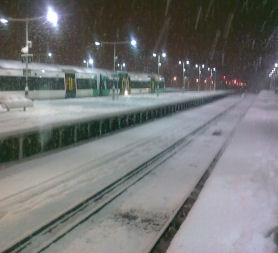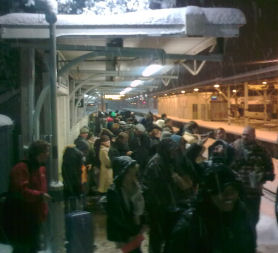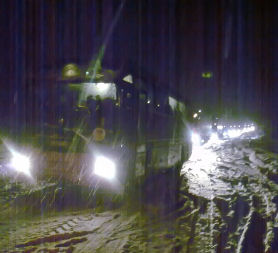Nightmare journey home as UK snow hits the London commute
As questions are asked about the preparedness of the government, rail services and travel firms, commuter Graham Lally writes for Channel 4 News about his nightmare journey from London to Brighton.

Left Victoria on the 8.17pm to Littlehampton, all going fine for a while.
Then about 20 minutes in we started seeing sparks coming off the rails, accompanied by losses of power. Gradually we slowed down, made Gatwick, then after a little while more stopped, and were informed of two broken trains in front of us, and some iced up points ahead. A little later, we heard there was a train down behind us as well, so we couldn’t go back to Gatwick either.
We must have sat there about three hours, with the news being that one team were getting to the trains to move them, while another wasn’t able to get out (from Brighton, maybe) to the points to defrost them.
Finally, we managed to creep into Three Bridges, sparking electricity like lightning out over the falling snow. Apparently it’s better to keep momentum going if you’ve got icy tracks, so sitting waiting for trains to move in front really didn’t help.
At Three Bridges, we were informed the track to Brighton was impassable. The plan at this point was to head back to Brighton via Littlehampton, i.e. return along the coast.
Shortly after, it seemed the mainline was usable again. But to do so, we needed to shunt the train back out the station and onto another line/platform, which meant everyone getting off and moving platform by foot.
Problem with the third railIt's the third rail, says Channel 4 News Science Correspondent Julian Rush. It's the way of getting the electricity to the train so it runs along. And it's a very old system. It started off in the Victorian era and all of a sudden when it was electrified in the 20s and the 30s, so you have a third rail which means that there's no overhead wires like they had in the rest of Europe.
It runs alongside the main rail and running rails of the train. The problem is that the collecting shoe, which sits on top of the rail and it slides on the top surface of the rail, it's what takes electricity from the rail into the train and it's vulnerable because snow can fall onto the rails and form a layer of ice which means that the collecting shoe can't make contact with the rail and so the train effectively breaks down.
There are other ways of doing it. The Docklands Light Railway for example is also a third rail system, but the collecting shoe is on the underside of the rail and so it's protected. Network Rail has a way of dealing with these sorts of things. It runs ghost trains and what are called de-icing trains, there's some 30 of them. They spray a de-icing fluid on that third rail to try and prevent that ice building up. A lot of them weren't able to get out last night says Network Rail, because their routes were blocked by the broken down trains.
Today the RMT union says that on some of those trains they weren't spraying enough de-icing fluid. Network Rail says that allegation is baseless and the company with the contract to do the de-icing is called DB Schenker, a division of Deutsche Bahn which says it's utter nonsense.
The issue is how much does it cost to change the infrastructure to make it safe? Network Rail for example is experimenting with strips of heaters on the connecting rail to try and heat the rails and it's not a new problem.
Back in 1904 a professor of Imperial College, Professor Silvanus P Thompson no less, wrote about the third rail "the live rail is itself already an obsolete device. It is an engineering blunder. I would therefore ask whether the time is not right for public opinion in some effective form to step in and prevent the railway engineers of England from committing our railway system to any further to the dangerous and unnecessary device."

Kind of lucky we did – the train shunted off, but then got stuck about 100m from the station, on an uphill part of the track. At this point we were occupying three or four waiting rooms – we had heaters, but were fairly cosy in them.
Worse was seeing three or four kids in among the crowd, who were actually fairly jolly to begin with. Really hoping they’re OK today. A few people passed round chocolates and food they’d bought in London for gifts, and the atmosphere was actually fairly chatty and “Britishly amused”.
After a while, it emerged not only was the train pretty stuck, but the mainline was impassable again. Apparently National Rail have three 4x4s they could send out, but only in an emergency – which apparently this wasn’t.
Rail staff did a great job at contacting local companies though. The cab company at the station didn’t want to send any cabs to Brighton for fear of not returning.

Then, from out the blue, a coach turned up, looking like it had come straight from the 60s. This filled up quickly, making sure the kids going back to Brighton were on board. I guess it took about 60 people.
At this point, someone next to me had managed to persuade a cab driver to drive to Brighton – for £140. Having a wife and five-week old boy to get back to, I figured money wasn’t so important after all. Four of us shared the cab back, almost getting stuck in more traffic on the A23.
I got back home at 4am, tired but with a weird buzz after seeing people come together a little, keep their nerve, etc. I only heard a handful of complaints in the end. I’ll still try to get a refund on my ticket though.
Not sure what happened to those that didn’t get on the bus. There were some more taxis waiting, but I understand the train didn’t get back till 6.30am, which sounds like pretty good going to me, given the conditions.
Would love to know more.